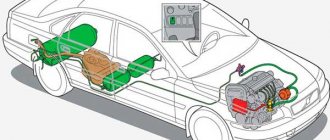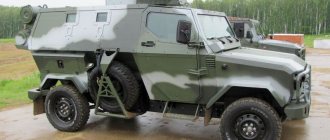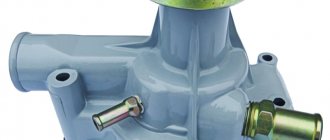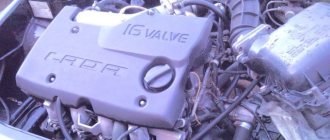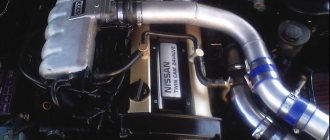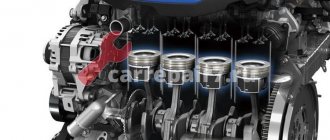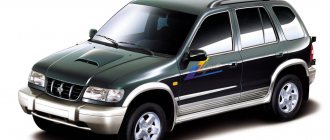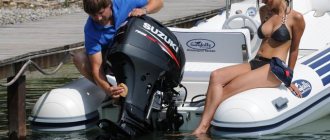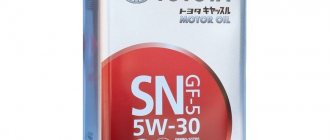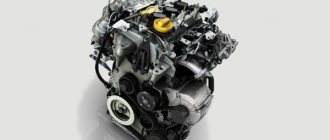The second generation Kia Sid with the JD index was introduced in 2012, and sales started in Russia in the summer of the same year. It was one of the most respected compact cars on the market. As before, the Ceed was offered in three body styles - a five- and three-door hatchback, as well as a station wagon.
The assembly of the car was carried out at the Kaliningrad Avtotor. For the European market, the car was produced in Slovakia.
The well-known ex-Audi designer Peter Schreyer worked on Sid's appearance. Despite a certain sporty style, the silhouette retained an almost straight roofline, which had a positive effect on the headroom of rear passengers.
Kia Ceed is one of the most spacious in the segment. Even with the front seats pushed back as far as possible, there is enough room for the riders' knees in the second row. There is no need to complain about the width of the cabin.
However, the space is okay not only in the front and back rows, but also in the trunk. Its volume is 380 liters and its shape is perfect. Thanks to the increased rear overhang, the station wagon has a trunk with a capacity of 528 liters.
In 2015, a restyling was carried out, but no major changes occurred. The designers focused on the details. On the outside, the radiator grille was slightly narrowed, and the rear lights were updated. The “artist’s” hand also touched the bumpers. In the interior, chrome was added to the front panel parts: the instrument panel and air duct deflectors. The updated version appeared on our market in October 2015.
In crash tests according to Euro NCAP, the Kia Sid earned five stars. All trim levels included six airbags.
Engines
The model has a wide variety of gasoline engines and two turbodiesels. But cars were officially supplied to Russia only with gasoline units of 1.4 and 1.6 liters (100 and 129 hp, respectively).
Three-door versions of the GT (Ceed and Pro_Ceed GT) received a 1.6 T-GDI petrol turbo engine with output of 204 hp. The engine from the Gamma family is equipped with direct fuel injection.
After restyling, GDI direct injection also appeared on the naturally aspirated 1.6, thanks to which its power increased to 135 hp. This unit was only available in the expensive Prestige and Premium versions.
The most widely used is the naturally aspirated 1.6 with distributed fuel injection, designated as G4FG. It differs from the G4FC by an additional timing clutch on the exhaust shaft. The motor is well known from other models of the brand. Its weak spot is the catalyst.
The neutralizer may become unusable after 50-70 thousand km - the honeycombs begin to deteriorate. Ceramic dust, in turn, can get into the cylinders, which will lead to the formation of scoring. One of the characteristic symptoms of problems with the catalyst is a drop in traction. The most accurate diagnostic method is to monitor the condition of the cells using an endoscope.
Previously, the warranty for the catalyst was 1 year or 1000 km. Since 2015, the manufacturer's liability period has been increased to 3 years or 100,000 km. It is worth noting that after restyling, the number of catalysts increased from one to two.
Since the new converter is very expensive, owners simply remove it, install “fake” ones on the oxygen sensors and reflash the ECU. The cost of a full “service package” in the service is about 10,000 rubles.
Until January 30, 2013, a so-called silent timing chain was installed, which could stretch prematurely. Later it was replaced by a regular one - more reliable.
The valves are adjusted by selecting pushers (600 rubles apiece). The official service will ask about 15,000 rubles for the procedure.
Engines Kia Ceed JD (2nd generation, 2012-2018)
All 2nd generation Kia Sid engines are gasoline and have four cylinders arranged in a row.
They are united by the presence of two camshafts in the cylinder head (DOHC) and a system that controls gas distribution phases (CVVT). As a base model, the Kia Ceed is equipped with a 100-horsepower G4FA with a volume of 1.4 liters. Next in the hierarchy is the 1.6-liter G4FG, followed by the slightly more powerful G4FD of the same volume. The G4FJ engine (1.6 liters, 204 horses) stands apart. They were equipped with a sports modification of the Kia Ceed GT.
ICE G4FA
Introduced in 2007, the 1.4 G4FA engine is installed on Hyundai and Kia models.
This representative of the Gamma family is often found on Rio, Solaris and serves as the base unit for the Kia Sid JD.
- exact volume - 1396 cm³;
- power - 100 hp;
- torque - 137 Nm;
- compression ratio - 10.5.
- Easy to maintain.
- Inexpensive spare parts and consumables.
- Economical fuel consumption.
- Doesn't bother you with minor damage.
- A good indicator of power in relation to volume.
- It makes noise when cold.
- Oil leaks occur periodically.
- Excessive vibrations in the mid-rpm range.
- Low maintainability.
The engine rarely presents serious problems.
Sometimes contamination of the throttle valve causes floating speed. Oil may leak from under the valve cover and sometimes the generator drive belt begins to whistle.
Created in 2010, the 1.6 G4FG internal combustion engine is the closest relative of the G4FC unit. Their main difference is the Dual CVVT system.
- exact volume - 1591 cm³;
- power - 129 hp;
- torque - 157 Nm;
- compression ratio - 10.5.
The pros and cons here are typical for Hyundai-Kia engines. There is no need to repeat ourselves here. But there is one big drawback known to many Kia Ceed 2 owners - scuffing in the cylinders. They occur due to the catalyst crumbling and its ceramic dust entering the cylinder block.
Typical malfunctions are the same as for other similar engines installed on Kia Sid. To these were added the above-mentioned scuff marks on the cylinder walls due to a failed catalyst.
In 2008, an internal combustion engine unit with direct fuel injection appeared for the first time in the Gamma series. The Hyundai 1.6 G4FD engine was created primarily for the European market with an eye on the strict environmental standards prevailing there.
- exact volume - 1591 cm³;
- power - 135 hp;
- torque - 164 Nm;
- compression ratio – 11.
The motor is reliable. It doesn’t extract a lot of money from the Kia Sid owner - consumables are inexpensive, fuel consumption is low for such power. And there are no difficulties in servicing. But here, as on other Kia Sid JD engines, there are vibrations at idle and medium speeds, the timing chain is noisy, and the injectors chirp. There are no hydraulic compensators, so periodic adjustment of the valves is indispensable. Many drivers note that G4FD does not digest low-quality gasoline well.
The list of problems here is still the same: floating speed, drive belt whistling and oil leaks. But this is a standard set of faults, there is nothing critical about them.
This representative of the Gamma series appeared in 2011 and is an almost complete copy of the 1.6-liter G4FD. The difference is the turbocharger that appeared on the 1.6 G4FJ. This engine is installed in the Kia Ceed GT version.
- exact volume – 1591 cm³;
- power – 204 hp;
- torque – 265 Nm;
- compression ratio – 9.5.
The turbocharged G4FJ is not much different from its family brothers. Except that the Kia Sid drives more cheerfully with it. Although overall the dynamics are not impressive, you want more from a unit with a power of 204 horses than it can give.
The motor does not present any particular problems. Sometimes the turbine starts to drive oil, and on almost new cars. But such cases are rare and the malfunction was fixed under warranty.
Transmission
Basic versions were equipped with a 6-speed manual transmission. As an alternative, a 6-speed automatic was provided for the 1.6.
After restyling, the Kia Ceed acquired a seven-speed DCT dual-clutch transmission. It came in tandem with a 1.4-liter turbo engine and a 1.6 CRDi turbodiesel. The petrol 1.6 GDI was combined only with a 6-speed robot. Both robots were developed jointly with LUK.
In cars with manual transmission, the input shaft oil seal may leak. In this case, transmission fluid gets into the clutch, which leads to clutch slipping. You can't always get rid of it by simply replacing the oil seal. Sometimes corrosion is found on the shaft, which means that the new oil seal will not last long. The case is recognized as a warranty case for Slovak-assembled vehicles manufactured before 08/28/2014. To update the seal, you need to open the box.
A robotic gearbox rarely causes serious problems, but malfunctions do occur. A new clutch kit will cost 80-90 thousand rubles.
A number of owners of cars with automatic transmission complain about noticeable jolts during braking. For the Ceed JD with naturally aspirated 1.6, a TSB (technical bulletin) was even issued, ordering that the transmission ECU (TCM) software be updated if a deficiency is detected in cars of the 13-14 model year. However, there are examples that have traveled over 300,000 km without any problems with the automatic transmission.
Possible engine malfunctions, their causes and solutions
With some skill and care, many malfunctions of the engine and its systems can be quite accurately determined by the color of the smoke coming out of the exhaust pipe. Blue smoke indicates oil getting into the combustion chambers, and constant smoking is a sign of severe wear of the cylinder-piston group parts. The appearance of smoke during throttling, after prolonged cranking with the starter, after long idling, or immediately after engine braking usually indicates wear of the valve stem seals. Black smoke occurs when the mixture is too rich due to a faulty engine management system or injectors. Blue or thick white smoke mixed with moisture (especially after the engine has overheated) means that coolant has entered the combustion chamber through a damaged cylinder head gasket. If this gasket is severely damaged, liquid sometimes enters the oil sump, the oil level rises sharply, and the oil itself turns into a cloudy whitish emulsion. White smoke (steam) when the engine is cold in wet or cold weather is normal. Quite often you can see a car standing in the middle of a city traffic jam with an open hood, emitting clouds of steam. Overheat. It’s better, of course, to prevent this by looking at the temperature gauge more often.
But no one is immune from the fact that the thermostat, electric fans may suddenly fail, or coolant may simply leak. If you miss the moment of overheating, do not panic and do not aggravate the situation. Overheating is not as dangerous as its possible consequences. Never immediately turn off the engine - it will suffer thermal shock and, perhaps, when it cools down, it will refuse to start at all. When you stop, let it idle, then fluid circulation will continue in the system. Turn on the heater at maximum power and open the hood. If possible, run cold water over the radiator. Only after achieving a decrease in temperature, stop the engine. But never immediately open the radiator cap on an overheated engine; a geyser from under the open cap is guaranteed. Take your time, let everything cool down, and you will preserve the health of the machine and your own health. Almost all instructions for the car contain a recommendation to depress the clutch when starting the engine. This recommendation is justified only when starting in severe frost, so as not to waste battery energy turning the shafts and gears of the gearbox in thickened oil. In other cases, this measure is aimed only at ensuring that the car does not move if the gear is engaged due to forgetfulness. This technique is harmful to the engine, since when the clutch is depressed, significant force is transmitted through it to the crankshaft thrust bearing, and during startup (especially cold), lubricant does not reach it for a long time. The bearing quickly wears out, the crankshaft receives axial play, and starting off begins to be accompanied by strong vibration. In order not to damage the engine, get into the habit of checking the position of the gear shift lever before starting and start the engine with the handbrake applied, without squeezing the clutch unless absolutely necessary.
Chassis
The Ceed handles well on well-paved roads. Handling and stability are excellent. But the suspension handles transverse irregularities relatively harshly and noisily.
After approximately 60-100 thousand km, the silent blocks of the rear levers wear out (from 700 rubles per lever). In addition, the camber bolts turn sour quite often. They have to be cut off.
After 80-120 thousand, the outer CV joint boot may give up. The original boot comes only assembled with a hinge. An analogue is available for 800 rubles. Another 2,500 rubles will have to be paid for the work.
On the segment of 100-150 thousand km, the front and rear shock absorbers give up the ghost (about 2500 rubles for an analogue). At the same time, it’s time for ball joints (700 – 1500 rubles).
It is worth noting that from May 2014, cars with modernized suspension were introduced. The changes affected the support bearings, springs, shock absorber mounts and the shock absorbers themselves.
Kia Sid CD engines (3 generations, 2018-)
Under the hood of the 3rd generation Kia Sid, regardless of the body type (hatchback or station wagon), you can find one of three gasoline engines.
The youngest in the line is the 1.4-liter G4LC - a naturally aspirated petrol unit. Its power is 100 hp. With. quite enough for moving around city streets. One step higher in the hierarchy is the 1.6-liter G4FC. With its 128 horsepower, the Ceed is noticeably more fun to drive. For those for whom this is not enough, a 1.4 G4LD petrol turbo engine with a capacity of 140 horses is offered.
Turbocharged G4LD
The engine was created in 2021 and belongs to the Carra family. Initially it was installed on the top-end Hyundai i30. A couple of years later, the Veloster and Kia Ceed CD received it. The Elantra is sold on the American market with the same engine derated to 130 hp. With.
This is a 1.4-liter petrol 4-cylinder in-line unit with a T-GDI direct injection power system.
The block and cylinder head are aluminum. The chain drives a timing belt with sixteen valves equipped with hydraulic compensators. The engine is equipped with a variable valve timing system and variable intake tract geometry.
(link to photo source)
Characteristics:
- exact engine volume - 1353 cm³;
- power - 140 l. With.;
- torque - 242 Nm;
- compression ratio - 10.
As for shortcomings and breakdowns, it’s too early to talk about them. The motor is very young and even dealers do not have enough reliable information about its weak points.
Some Kia Ceed owners complain about a whistling factory alternator belt and loud injectors.
G4LC
This is another representative of the Carra family. Since 2015, a 1.4-liter gasoline engine has been installed as the main engine in compact and mid-size Hyundai and Kia models.
This engine is in many ways similar to the G4LD turbo engine. Their main difference is the power system and the amount of horsepower. In addition, the G4LC has a 0.4 mm larger diameter of each cylinder.
(link to photo source)
Characteristics:
- exact engine capacity - 1368 cm³;
- power - 100 l. With.;
- torque - 134 Nm;
- compression ratio - 10.5;
The motor was created not so long ago. We can talk about the characteristic shortcomings in a few years. In the meantime, the owners of the Kia Sid CD note that the sound produced by the injectors and the whistling of the drive belt are too loud.
G4FC
And this is already a representative of the Gamma engine family, which is well known in our country. The 1.6-liter unit was created in 2007. It was equipped with popular models of the Korean concern. On the Kia Ceed 3, the engine is available with both manual and automatic transmission.
The four-cylinder block and head are aluminum, the intake manifold is made of plastic. The timing chain drives two camshafts with sixteen valves. Distributed fuel injection. Only the intake shaft is equipped with a phase regulator.
(link to photo source)
Characteristics:
- exact volume – 1591 cm³;
- power – 128 hp;
- torque – 155 Nm;
- compression ratio – 10.5.
The engine turned out to be simple and relatively reliable, with no inherent problems. He has a moderate appetite and reasonable prices for parts.
The most significant drawback of the 1.6 G4FC is the disposability of the design. Also, the disadvantages include increased vibrations, noisy operation and the lack of hydraulic compensators.
The list of typical faults is not long:
- The drive belt whistles (can be treated by tightening or replacing the tensioner).
- The speed fluctuates (cleaning the damper helps).
- Oil leaks from under the valve cover.
Steering
The second generation Kia Ceed, like its predecessor, has electric power steering. From time to time he causes criticism. Owners indicate the steering wheel biting in the zero zone or steering (steering). Sometimes it was possible to eliminate the disease after calibrating the EUR. For some, the amplifier was replaced under warranty.
Unhealthy symptoms appear more often during the cold season. This gives reason to believe that the whole issue is lubrication or insufficient quantity of it in the mechanical part of the amplifier. Filling the “mechanics” with grease often solved the problem.
There is also another flaw - a knocking sound in the steering. The official service center dealt with the disease by replacing either the persistent bolt in the steering rack, or the elastic coupling, or the steering cardan.
On Sidahs with adaptive steering, a knocking or clicking sound when turning the steering wheel occurred due to play between the adaptive power steering bushing and the hood cross member bracket. The defect, in accordance with Kia's instructions, was eliminated by installing a washer between the bushing and the bracket. The problem is typical for cars manufactured before November 25, 2014, but it also occurred in 2015 models.
Vehicle overview
This car has been produced since 2006. The prototype was first shown at the Geneva Motor Show in the spring of 2006. In the fall of the same year, the final version was presented in Paris, which went into production.
The first cars were produced in Slovakia at a plant located in the city of Zilina. The model was developed directly for Europe, so production was initially planned only in Slovakia. Assembly of almost the entire line began immediately; a convertible was added in 2008.
Since 2007, the car has been produced in Russia. The process was established in the Kaliningrad region.
Please note that the first generation shares the same platform with the Hyundai i30. Therefore, they have the same engines and gearboxes. This fact sometimes confuses drivers when they are offered in stores to buy components that are intended for Hyundai.
In 2009, the model was slightly updated. But this affected mainly the interior and exterior. Therefore, within the framework of this article, we will not consider the features of restyled cars of the first generation.
Second generation
This generation of Kia Sid can be considered the current one. Cars have been produced since 2012 until now. First of all, engineers brought the appearance in line with current requirements. Thanks to this, the model began to look quite fresh and modern.
New powertrains have been added to the powertrain lineup. This approach made it possible to select a modification individually for each car enthusiast. Also, some of the engines already in use received a turbine. Cars that received turbocharged power units have a more sporty appearance; they have the Sport prefix. In addition to a more powerful engine, there are completely different settings for the suspension and other structural elements.
The second generation Kia Sid cars are produced at the same factories as before. All of them are also designed for Europeans. Overall, this is a fairly high-quality C-class car, ideal for use in the city.
Body and interior
Ceed JD paintwork is not resistant to aggressive environments and external influences. With age, paint blistering is observed on the tailgate, windshield frame and sills.
Over time, vertical scratches appear on the front and rear side windows. It's all about the "velvets". Later, a technical bulletin was issued instructing customers to replace the seals with modernized ones when contacting them.
Scuffs on the steering wheel were often discovered after 30-60 thousand km. Official services sometimes replaced the steering wheel under warranty. However, there are examples with a mileage close to 100,000 km without signs of wear.
The combined upholstery of the chairs (a combination of leather and fabric) is also not durable. As a rule, leather inserts burst. Unfortunately, the defect was not always recognized as covered by warranty.
From time to time, plastic begins to creak in the cabin.
After 60-100 thousand km, the windshield wipers may become mopey - the trapezoid turns sour. First, the speed of movement of the brushes decreases, and then they completely freeze. As a rule, the case is recognized as a warranty case. The cost of a new original trapeze is more than 6,000 rubles.
After 100-150 thousand km, the rear view camera may fail. Instead of an image, you have to see a black or blue screen. The camera has a 5-year warranty. Station wagons of the 2012-2014 model year if the camera fogs up or fails due to water ingress can count on a free replacement.
It is not uncommon for the DRL lights to flicker or go out. More often the left headlight is affected. The reason is driver failure due to overheating. The design of the headlight does not provide for the replacement of a faulty electronic board. A new headlight with xenon would cost 75,000 rubles. But the craftsmen learned to disassemble and replace the board, which costs 1,500 rubles.
On cars assembled before June 2013, the seat heating control unit often failed. The disease was manifested by weak heating of the front seats. For a new controller they will ask around 15,000 rubles. Heating problems can also arise due to broken mat threads.
Timing chains
There are two chains in the timing drive. And they tend to stretch, especially the top one. Stretching occurs after a mileage of 120,000 - 150,000 km. The stretch can be “heard” by a characteristic chirping sound and cannot be neglected - the chain can jump or “plane” chips upon contact with the plastic casing. A set of timing chains with dampers costs under $300. The kit is the same for engines 1.1, 1.5, 1.6.
You can buy a contract 1.6 CRDI engine for Kia or Hyundai with a guarantee and delivery from ]AutoStrong-M[/anchor].
